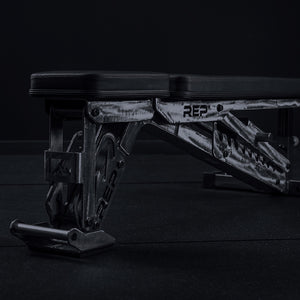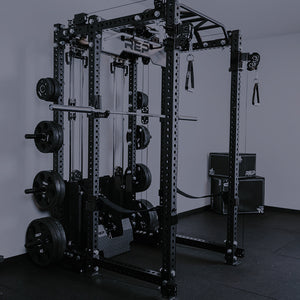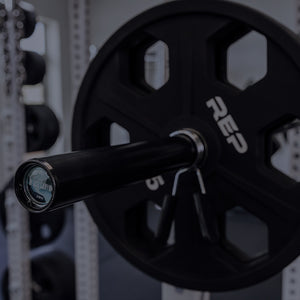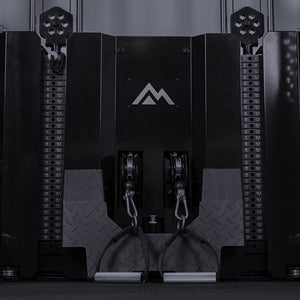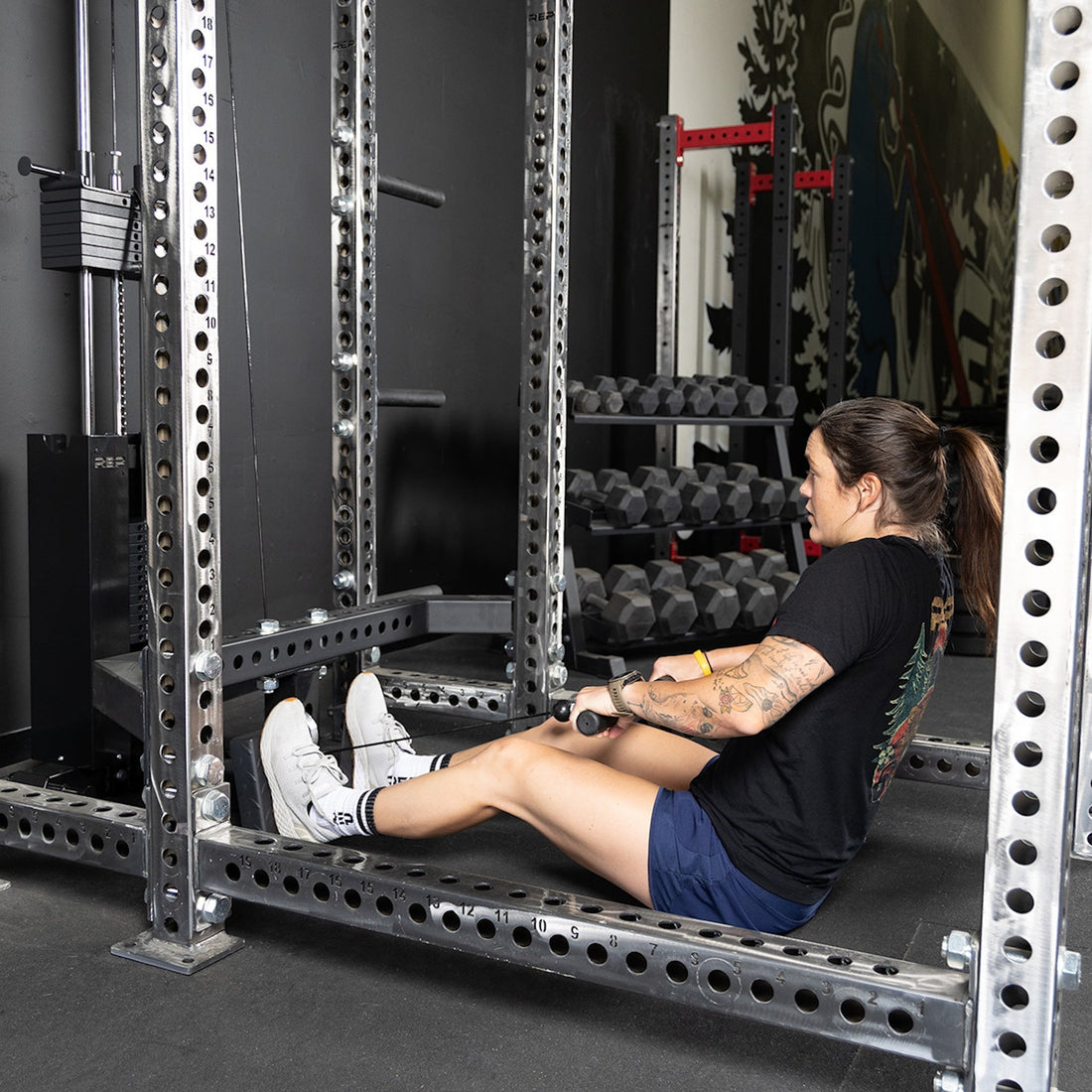
The seated cable low row is one of those go-to exercises that packs a punch for your back. It’s all about building a strong, muscular, and balanced upper body, making it a must-do in your workout routine.
Whether you're just starting out or you’ve been lifting for years, getting the hang of this move can seriously boost your strength and improve your posture. Plus, it’s fun to see your back muscles pop as you master the technique.
Here’s a look at how to do the seated cable low row with proper technique; the muscles it works; variations like the single-arm low row; and alternatives to keep your workouts fresh and challenging.
How to Do Low Row: Technique and Form
Mastering the seated cable low row starts with understanding the correct technique. Here's a step-by-step guide:
Set Up the Cable Machine: Attach a Triangle Row, REP® x Kleva Built™ Atlas close-grip cable and landmine handle attachment, or Open Row handle to the lowest pulley position on a cable machine like the Arcadia® Max functional trainer or Adonis™ cable tower. Adjust the weight to an appropriate level for your strength.
Position Yourself: Sit on the bench or platform with your feet securely placed on the footrests or against the machine. Different functional trainers have different setups.
For example, on the Arcadia ® Max functional trainer, try slightly angling an incline bench, bracing your feet against the floor (see below).

You can even just simply sit on the floor, depending on the angle you want (as shown here on the Adonis™ cable tower).

Or use a bench but keep it flat to create a slightly different angle, as shown here on the REP Ares™ 2.0 cable attachment.

Fun facts: The REP Ares™ 2.0 was designed with a slightly higher cable point that’s more comfortable and functional than a typical low row. This allows you to sit on the bench or the floor; it’s your choice. The improved footplate design is angled at the top to provide support while sitting on the bench and it adjusts for multiple starting points for better foot positioning. The footplate is also wider than previous models for more comfort and versatility, with the cables in the middle of your feet rather than on the outside.
Regardless of where you sit and which cable machine you use, your knees should be slightly bent, and your torso upright. Keep your back straight, chest out, and shoulders back.
Grip the Handle: Reach forward and grab the handle with both hands. You can choose from a variety of handles and grips, but the most common low row is on a Triangle Bar using a neutral grip (palms facing each other). A cable seat row close grip will work slightly different muscles than a wide grip seated cable row.
Starting Position: Pull the handle toward your torso, keeping your elbows close to your body. Your arms should be fully extended, with a slight bend in your elbows. This is your starting position.
Execute the Row: Begin the row by pulling the handle toward your abdomen, driving your elbows backward while keeping them close to your sides. Focus on squeezing your shoulder blades together at the peak of the movement.
Control the Return: Slowly extend your arms back to the starting position, allowing the weight to return to the stack under control. Avoid rounding your back or letting your shoulders slump forward.
Repeat: Perform the desired number of repetitions, maintaining control and proper form throughout.
Low Row Form Tips

Maintain a neutral spine: Keep your back straight and avoid rounding your shoulders.
Engage your core: A tight core helps stabilize your torso during the exercise.
Focus on your back muscles: Visualize your back muscles doing the work, rather than just pulling with your arms.
Low Row Muscles Worked

The seated cable low row is a compound movement that engages multiple muscle groups, primarily targeting the muscles of the back. Here's a breakdown of the low row muscles worked:
Latissimus Dorsi (Lats): The largest muscle in the back, responsible for pulling movements and adding width to your back.
Rhomboids: Located between your shoulder blades, these muscles retract the scapula, contributing to a strong and stable upper back.
Trapezius (Traps): The traps support the shoulder girdle and help in scapular movement and stability.
Biceps Brachii: While not the primary muscle group, the biceps assist in the pulling motion.
Erector Spinae: These muscles run along your spine and help maintain proper posture during the row.
Posterior Deltoids: The rear part of your shoulders, which are engaged during the rowing motion.
Understanding the muscles worked can help you focus on proper form and ensure you're targeting the right areas during the exercise.
Single Arm Low Row: A Powerful Variation
The single arm low row is a variation of the traditional seated cable low row that allows for unilateral training. This variation helps address muscle imbalances and enhances mind-muscle connection.
Here's how to do it:
Set Up: Attach a D-handle to the low pulley of your cable machine.
Position Yourself: Sit on the bench and grip the handle with one hand, while the other hand rests on your hip or the bench for support.
Row, Row, Row: Pull the handle toward your torso, keeping your elbow close to your side. Focus on squeezing your back muscles and maintaining a stable, upright posture.
Alternate Sides: After completing the reps on one side, switch to the other arm.
The single arm low row can be particularly effective in targeting the lats and improving symmetry in your back development.
Other Seated Cable Row Alternatives
While the seated cable low row is a fantastic exercise for building a strong back, it's important to incorporate variations and alternatives to keep your workouts dynamic. Beyond the single-arm row, try these alternatives:
High to Low Rows
High to low rows involve pulling a cable from a high position down toward your body, targeting the upper back and rear deltoids.
How to Do It:
- Attach a handle to a high pulley.
- Stand facing the cable machine with a slight bend in your knees.
- Pull the handle down and back toward your torso, keeping your elbow high.
- Focus on squeezing your upper back muscles at the peak of the movement.
Low Cable Row Standing
The standing low cable row is a functional variation that engages your core and lower body, along with your back muscles. This exercise can be performed on a cable machine or functional trainer.
How to Do It:
- Attach a handle to a low pulley.
- Stand facing the machine, feet shoulder-width apart, knees slightly bent.
- Pull the handle toward your torso while maintaining an upright posture.
- Focus on driving your elbows back and engaging your core throughout the movement.
Iso Lateral Low Row

The iso lateral low row performed on REP’s ISO Arms rack attachment allows for isolated, unilateral training. This variation emphasizes balanced muscle development and can be integrated into your back workouts for added intensity.
How to Do It:
- Attach the ISO Arms to your power rack at the right height.
- Position yourself in a staggered stance, gripping one arm at a time.
- Pull the arm toward your torso, focusing on a controlled contraction of the back muscles.
- Alternate arms after completing your reps.
Equipment and Attachments to Enhance Your Low Row Workouts
The right equipment and attachments can lever up your low row exercise and provide variety to your training routine. Here are some attachments to consider:
Triangle Row Attachment

The Triangle Row Attachment provides a comfortable grip for the low row and allows for a full range of motion. The neutral grip position targets the back muscles effectively while reducing strain on the wrists.
Open Row Attachment

The Open Row Attachment offers a unique open design that encourages a natural hand position during rows, improving grip comfort and allowing for a more effective back workout. You can also get a deeper range of motion with an Open Row because of how the handles are placed.
Pro Series Triangle Row Attachment

The Pro Series Triangle Row Attachment is designed for serious lifters, providing an ergonomic grip and durable construction. It's perfect for heavy-duty rowing exercises on cable machines. Think of it like a normal Triangle Row – but better.
D-Handle Cable Attachment

A D-Handle is great for single arm low rows. It’s versatile enough for a ton of other cable exercises, making it a valuable addition to your gym setup.
Straight Bar

To use a Straight Bar for low rows, grip the bar with an overhand or underhand grip, and pull the bar toward your torso while keeping your elbows close to your sides. Focus on squeezing your shoulder blades together and maintaining a straight back throughout the movement.
Bottom Line
The seated cable low row is a fundamental exercise for building a strong, muscular back. By mastering the proper technique, understanding the muscles worked, and incorporating variations like the single arm low row, you can optimize your back workouts for maximum results.
Plus, exploring seated cable row alternatives and experimenting with new attachments can help keep your training routine diverse and challenging.
Whether you're working out at home or in a commercial gym, incorporating these exercises and equipment into your routine will help you build a well-rounded, powerful back.
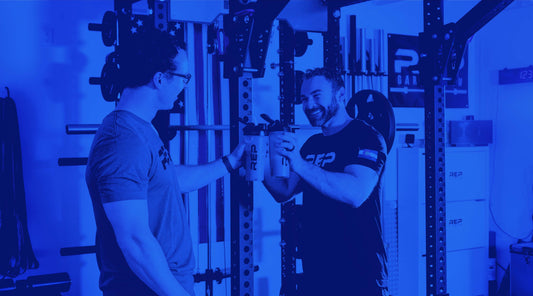
NEWSLETTER SIGNUP
Product launch information, promotions, blogs, and REP news.

